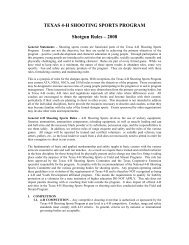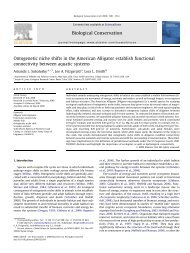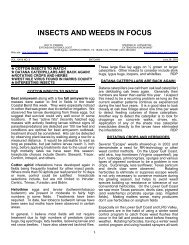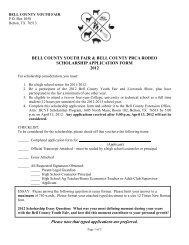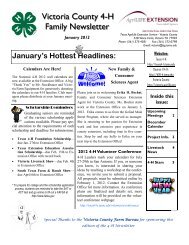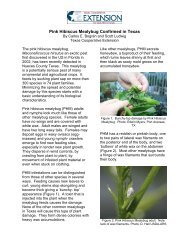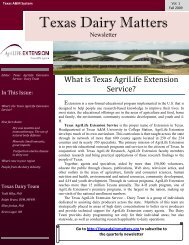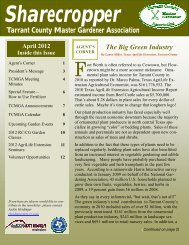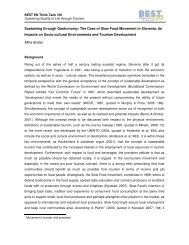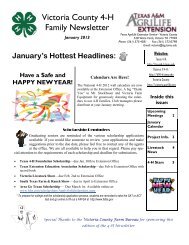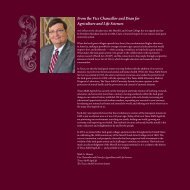Tarrant County Master Gardener Association - Texas A&M AgriLife ...
Tarrant County Master Gardener Association - Texas A&M AgriLife ...
Tarrant County Master Gardener Association - Texas A&M AgriLife ...
Create successful ePaper yourself
Turn your PDF publications into a flip-book with our unique Google optimized e-Paper software.
Sharecropper<br />
<strong>Tarrant</strong> <strong>County</strong> <strong>Master</strong> <strong>Gardener</strong> <strong>Association</strong><br />
July 2012<br />
Inside this Issue<br />
AGENT’S<br />
CORNER<br />
Understanding Natural Fertilizers<br />
By Steve Chaney, <strong>Texas</strong> <strong>AgriLife</strong> Extension, <strong>Tarrant</strong> <strong>County</strong><br />
Agent’s Corner 1<br />
President’s Message 4<br />
TCMGA Meeting<br />
Minutes<br />
Cedar Hill Field Trip 6<br />
TCMGA Announcements 7-8<br />
TCMGA Calendar 9<br />
2012 RC/CG Garden<br />
Classes<br />
2012 <strong>AgriLife</strong> Extension<br />
Seminars<br />
5<br />
10<br />
11<br />
Volunteer Opportunities 12<br />
If you have an idea or would like to contribute<br />
to the newsletter, please contact<br />
Jackie Heidinger<br />
rheidinger@tx.rr.com.<br />
If you want to have a healthy, productive garden the first key step is to build<br />
great soil. Many gardeners make the mistake of looking first to fertilizers, tonics,<br />
or a multitude of miracle working concoctions to produce great plants.<br />
There is no long-term substitute for proper soil building. If your soil is poorly<br />
drained, too acidic or alkaline, compacted, low in organic matter or has poor<br />
structural characteristics, it doesn’t matter how much fertilizer you add, the<br />
results will be disappointing.<br />
Build your soil first and then fertilizers can play their proper role in promoting<br />
plant health and production. Fertilizers are most effective when used to fine<br />
tune a soil situation that is already working relatively well. Healthy soil grows<br />
healthy, productive plants and is the place where any great garden begins.<br />
Start by adding compost to improve the soil’s structure, internal drainage and<br />
water holding ability. It stimulates soil microbes and breaks down to feed<br />
plants gradually over time. If drainage is at all in question, build raised planting<br />
beds to insure that plant roots don’t sit in soggy wet conditions.<br />
Have your soil tested to determine the pH and nutrient levels. This provides the<br />
basis for correcting deficiencies and preventing nutrient excesses or imbalances.<br />
When you get the soil right, plants will naturally thrive. Once the soil has<br />
been properly prepared it is time for planting and any fertilizer additions. I just<br />
want to stress that fertilizer is a wonderful thing for fine tuning plant health and<br />
stimulating maximum production, but is not a fix-all for poor soil conditions.<br />
Compost and manure are soil conditioners that build the soil. While they contain<br />
nutrients, their nutrient content is fairly low and as such they are generally<br />
not considered fertilizer. Some animal manures (such as poultry manure) are<br />
more potent and as such are sometimes formulated into fertilizer blends, but<br />
most should be viewed more as a soil amendment.<br />
Natural vs. Organic<br />
The focus of this article is on natural fertilizers as opposed to synthetic products.<br />
Sometimes the words natural and organic are used interchangeably but<br />
this is not correct. Not everything of natural origin can legally be called organic.<br />
Some fertilizers are officially designated as organic, a term reserved for<br />
those products that meet strict requirements, originally specified by the <strong>Texas</strong><br />
Department of Agriculture and now superseded by the USDA’s organic regulations.<br />
As a result, many natural products are not officially certified as organic.<br />
Rather than get tied up in official laws and regulations, I will simply focus on<br />
products that are natural in origin to distinguish these fertilizers from<br />
(Continued on page 2)
Sharecropper Agent’s Corner—Understanding Natural Fertilizers, cont’d Page 2<br />
“synthetic” or “chemical” products. Growers wanting to<br />
produce vegetables and fruits organically will need to verify<br />
a particular fertilizer’s status before using it on their<br />
crops.<br />
Why Use Natural Fertilizers<br />
Natural fertilizers are typically lower in nutrients than their<br />
synthetic counterparts. They also tend to be more expensive<br />
per unit of nutrient. Additionally, plants take up nutrients in<br />
their basic form, not in a synthetic or organic form. Thus<br />
whatever type of fertilizer you use, it will have to break<br />
down into the same basic elements for plants to be able to<br />
take those elements up.<br />
So why use a natural fertilizer? One reason for gardeners<br />
wanting to grow things naturally is simply the fact that they<br />
are natural as opposed to synthetic. Gardening is a hobby<br />
and source of enjoyment and fulfillment. It is generally not<br />
a means to survival and so a few dollars on a natural fertilizer<br />
is not significant when you consider that gardening is<br />
really a quite inexpensive hobby…or at least it can be,<br />
right?<br />
Synthetic fertilizers release nutrients rapidly in most cases,<br />
and are often salt based. Thus they can burn plants, something<br />
very few natural products will do. The natural fertilizers<br />
release their nutrients gradually as they break down by<br />
microbial action. This extends the nutrient release to gradually<br />
provide plants nutrition over time. It also helps to reduce<br />
water pollution through runoff and leaching. In recent<br />
greenhouse turf studies at <strong>Texas</strong> A&M University, several<br />
natural fertilizers produced a top quality turf and had much<br />
lower rates of runoff and leaching than several synthetic<br />
blends tested.<br />
Natural products stimulate soil microbial activity and in a<br />
small way add organic matter to the soil. They contribute to<br />
the process of building soil. They are not just 3 major elements<br />
in a bag of filler but being derived from once living<br />
materials contribute micronutrients and often other plant<br />
growth stimulating substances.<br />
Types of Natural Fertilizers<br />
Natural fertilizers may be divided into three basic categories<br />
based on their origins: plant based, animal based and<br />
minerals. Plant based fertilizers include alfalfa meal, corn<br />
gluten meal, cottonseed meal, and kelp meal. Animal based<br />
fertilizers are primarily a byproduct of the meat processing<br />
industry and the commercial fishing industry. Common<br />
animal based fertilizers include blood meal, bone meal,<br />
feather meal, fish meal and fish emulsion. Mineral fertilizers<br />
are mined from the earth. They include greensand, gypsum,<br />
lime, soft rock phosphate, and potassium magnesium<br />
sulfate. Let’s take a look at these natural fertilizers individually.<br />
lfalfa Meal is used for animal feed. It contains<br />
A about 3% nitrogen and makes a good low concentration<br />
fertilizer. I have even used pelletized rabbit feed<br />
in the garden as it is much the same as alfalfa meal.<br />
lood Meal is a byproduct of slaughterhouses. The<br />
B blood is collected, dried and powdered. It is very<br />
rich in nitrogen (about 12%) and in fact is a top choice<br />
among natural products when only nitrogen is needed. It<br />
also contains trace elements including iron. This however<br />
is one natural product that can burn plants if used in excess,<br />
so take care to not over apply it.<br />
one Meal comes from the slaughterhouses and is<br />
B one of the better known natural fertilizers. It contains<br />
about 12% phosphate, most of which is available.<br />
This makes it a good choice for a fairly quick fix. Many<br />
soils already contain high levels of phosphorus, which<br />
leads to iron tie up and subsequent iron deficiency of the<br />
plants. Take care not to overuse this “middle number” on<br />
the fertilizer label, and base any phosphorus additions on<br />
soil test results.<br />
orn Gluten Meal is derived from grain corn. It is<br />
C high in nitrogen, containing about 10% and as<br />
such makes a great supplement for many garden and<br />
lawn uses. It also has some weed deterrent qualities, so<br />
you should take care when using this product in a garden<br />
where seeds may be planted within a couple of months.<br />
ottonseed Meal is a byproduct of the cotton industry.<br />
It is used in producing livestock feed but also<br />
C<br />
makes a great fertilizer. It tends to be somewhat acidifying,<br />
a very positive trait for gardeners in the western<br />
2/3’s of the state or for east <strong>Texas</strong> gardeners growing<br />
azaleas, camellias, and blueberries. It is a good source of<br />
nitrogen and generally has a nutrient content of about 6-2<br />
-2.<br />
eather Meal is acquired from the poultry industry.<br />
F The ground material is high in nitrogen<br />
(approximately 12%) but is in a form that is very slowly<br />
available. Therefore it is more effectively used for long<br />
term nitrogen supplementation rather than as a quick fix<br />
for a growing crop of vegetables.<br />
ish Meal contains about 10% nitrogen. It is very<br />
F useful in giving plants a boost of this primary nutrient.<br />
I like to mix some into the soil prior to planting<br />
and also use it to side dress plants when they need a little<br />
extra vigor.<br />
ish Emulsion is made up of finely ground fish<br />
F parts that have been partially decomposed. It is<br />
high in nitrogen and trace elements. Specific nutrient<br />
content is about 5-1-1 but varies considerably among
Sharecropper Agent’s Corner—Understanding Natural Fertilizers, cont’d Page 3<br />
various manufacturers and depending on how it is processed.<br />
This product is a favorite for both soil application<br />
and foliar feeding when diluted properly. The older types<br />
had an odor that let the neighborhood know you had fertilized<br />
and would most likely have every cat in town salivating<br />
big time. The odor dissipates in a couple of days, but<br />
you would not want to use it on indoor plants for sure!<br />
Newer formulations are available which have been pretty<br />
much deodorized.<br />
reensand is a clay type mineral, also known as glauconite,<br />
which contains about 5% potash. The nutrient<br />
G<br />
is tightly bound up in the compound and is only very slowly<br />
available. It is much better suited to long term soil building<br />
than quick fix results.<br />
elp Meal is basically seaweed that has been dried<br />
K and ground. It is low in nutrients, containing about<br />
1% nitrogen and 2% potash, but it also contains magnesium,<br />
sulfur and many trace elements. There are also many<br />
seaweed extracts that are popular as a foliar applied product.<br />
ypsum is most commonly promoted as a way to<br />
G “fix” tight clay soils. However it works only on<br />
clays that have high levels of sodium which destroys soil<br />
structure resulting in tight, poorly drained soils. Gypsum<br />
knocks the sodium off the soil particles replacing it with<br />
magnesium and thus leading to better structure. Gypsum<br />
will not help just any clay. It provides the nutrients calcium<br />
and sulfur and is a good way to supplement these nutrients<br />
when they are lacking.<br />
ime is basically a source of calcium and a way to raise<br />
L pH in an acid soil. It is mined from the earth and is<br />
primarily needed in the east <strong>Texas</strong> areas where acidic soils<br />
prevail. Dolomitic lime also contains magnesium, another<br />
element often lacking in the acid sands of east <strong>Texas</strong>.<br />
oft Rock Phosphate is mined from ancient marine<br />
S deposits. It contains about 30% phosphate but most is<br />
unavailable to plants at any given time. In fact only 1 to 2%<br />
is available. Very slowly over time this phosphate is released<br />
to the soil solution where plants can receive the nutrients.<br />
This is a good long term solution in soils where<br />
phosphorus is lacking.<br />
otassium Magnesium Sulfate is also known as langbeinite.<br />
It is mined from the earth and ground for sale<br />
P<br />
as a fertilizer. This fertilizer contains 22% potash as well as<br />
18% Mg and 27% sulfur. Companies often process this material<br />
into various forms, which are thus a bit less “natural”<br />
perhaps than the mined form. Sul Po Mag and K Mag are<br />
two common brand names of potassium magnesium sulfate<br />
fertilizer.<br />
Blends are combinations of ingredients formulated into fertilizers<br />
with popular ratios of nitrogen, phosphorus and<br />
potassium. For most purposes in most areas of the state,<br />
in the absence of a soil test a good rule of thumb is to<br />
apply a 4-1-2 or 3-1-2 blend of nutrients. This avoids<br />
adding too much phosphorus, while provides nitrogen,<br />
which is almost always needed and potassium, which is<br />
also often needed.<br />
Many of these natural fertilizer products are available in<br />
local garden centers. Others may not be locally available.<br />
Buying them by mail order can be expensive. In such<br />
cases it is often best to make do with locally available<br />
products. Plant nutrition is not an exact science and although<br />
it is easy to get lost in the numbers just remember<br />
that well built soil is very forgiving and exact blends are<br />
not essential.<br />
Conclusion<br />
Natural fertilizers can be an integral part of a good soil<br />
building program for your garden and landscape. Along<br />
with compost additions and soil testing they provide the<br />
basis for a healthy productive garden.<br />
Remember to start with a soil test to determine your<br />
soil’s current nutrient status and needs. Build soil prior to<br />
planting and continue to improve it by amendments and<br />
proper fertilizing each time you transition from one crop<br />
to another.<br />
While some natural fertilizers provide a quick fix, similar<br />
to the way synthetic products can, most are part of a long<br />
-term solution. The goal is to build soil that need few<br />
additional inputs rather than soil dependent on a continual<br />
series of “quick fixes”. <strong>Gardener</strong>s who want to garden<br />
naturally are willing to build their gardens over time recognize<br />
the value in such an approach. They will enjoy<br />
the benefits for years to come in terms of great soil,<br />
healthy plants, and productive gardens.
Sharecropper President’s Message– June 2012<br />
Page 4<br />
Dear <strong>Gardener</strong> Friends,<br />
Wow, what a difference a year makes. This year Mother Nature has blessed us with more rain. Our<br />
gardens and trees are thankful as they prepare to endure the summer heat.<br />
I hope you had as much fun as I did at our Annual Garage Sale in June. The project presentations and<br />
the mini classes gave us a taste of the knowledge and commitment to education by our members. Thank you to all project<br />
chairs and mini-session teachers.<br />
Thank you Claire Alford for organizing the event and Theresa Thomas and your helpers for executing her vision. Thank<br />
you Shirley Mills and your hospitality team for coordinating lunch. Thank you Dave Wilson for another delicious BBQ<br />
meal. Thank you Donna Fry, Susan Stanek and your team for managing the garage sale and general silent auction area.<br />
Thank you Pam Braak and your team of cashiers as we paid for our treasures. You made this event successful through<br />
your attendance and participation. The projects benefit from the additional income and volunteers. Thank YOU!<br />
The July monthly meeting will be Thursday, July 5 (day after 4 th of July.) As a holiday week, we would like to try a different<br />
meeting format. Members are encouraged to come between 9 – 10 am and enjoy brunch. The general business<br />
meeting will begin at 10 am with officer and chair reports and unfinished business of voting on the nominees for the nominating<br />
committee. Members will vote by ballot for 4 nominees from a list of six (6) members (so far.) The complete list<br />
of names can be found in the July Sharecropper.<br />
While the ballots are being counted by Steve Purdy, membership chair, we will enjoy our July speaker. At the conclusion<br />
of the speaker’s program, the results of the ballots will be announced and we will wrap-up the business meeting. We anticipate<br />
the meeting will close by 12:30 pm.<br />
The TCMGA will host a Regional Conference Saturday, October 13. Many of the speakers have been identified; however,<br />
we are still in the planning phase. There are many areas of need for a conference this size and everyone is welcome<br />
to be a part of this event. If you are unable to participate in the planning phase, mark your calendar to either volunteer or<br />
attend the day of the conference. More information will be available in the coming weeks.<br />
The 2012 Interns have been busy working on their group project at the Botanic Garden Children’s Vegetable Garden with<br />
the help of their intern advisor, Ron Schlitzer. Their project will be the center-piece to the renovated BG CVG. You will<br />
be amazed at the transformation of this garden. The Interns have also been volunteering around <strong>Tarrant</strong> <strong>County</strong> at numerous<br />
TCMGA projects.<br />
The word is out…..<strong>Tarrant</strong> <strong>County</strong> <strong>Master</strong> <strong>Gardener</strong>s are great! The requests for <strong>Master</strong> <strong>Gardener</strong> speakers have doubled<br />
for the year as well as requests to attend various farmer’s markets and events.<br />
Do you like to talk to people about gardening or garden-related topics, but you’re worried you don’t know enough about<br />
your topic to speak on the subject? As a <strong>Master</strong> <strong>Gardener</strong>, you have more knowledge about gardening than the average<br />
person, plus access to research-based information and power point presentations on a variety of topics. Become a part of<br />
the Speaker’s Bureau. Contact Camille Thomason to be added to the SB email list.<br />
Would you like to take a Specialist Class on a subject that interests you? It takes a little extra effort, but the knowledge<br />
you receive is invaluable. I recently attended a Propagation Specialist class with a good friend. We had a great time,<br />
learned a lot and have applied techniques we learned with more success than we imagined. Plus, we look forward to sharing<br />
what we learned with others in the coming months.<br />
A list of Specialist classes can be found on the <strong>Texas</strong> <strong>Master</strong> <strong>Gardener</strong> website (tarrantmg.org). Check them out and plan<br />
to attend. The TMG offers a small reimbursement and the TCMGA offers a partial reimbursement to help with expenses.<br />
Guidelines can be found on the TMG and TCMGA websites.<br />
Our lives are busy but don’t forget to smile, laugh, and enjoy time with family and friends every day.<br />
See you in the garden!<br />
Nancy Curl, President<br />
<strong>Tarrant</strong> <strong>County</strong> <strong>Master</strong> <strong>Gardener</strong>s
Minutes of the May 3, 2012 TCMGA General Meeting<br />
Sharecropper Page 5<br />
This meeting is our annual garage sale and silent auction.<br />
There was no other program.<br />
President Nancy Curl called the meeting to order at<br />
11:05am. She welcomed all visitors and members in attendance.<br />
Attendance was 203 certified <strong>Master</strong> <strong>Gardener</strong>s,<br />
Interns and visitors.<br />
Executive Board<br />
The May minutes were approved as published in the<br />
newsletter.<br />
Claire Alford, First Vice President, was not in attendance.<br />
President Curl thanked her for all her hard work<br />
making the garage sale a success.<br />
Pam Braak, Treasurer, informed us of the final profit<br />
from the plant sale. $4662 will be divided between the<br />
Community Garden and all projects, with 75% going to<br />
the Community Garden. All income from the garage<br />
sale will go to projects.<br />
The Treasurers Report For the Month Ended May 31, 2012<br />
Cash, Beginning 5/1/2012 38,582.09<br />
Deposits during month 2,178.90<br />
Checks during month ___ (2,581.10)<br />
Cash, Ending 5/31/2012 38,179.89<br />
There were no questions and the treasurer’s report was<br />
filed.<br />
Steve Chaney was away at a conference.<br />
Committee Reports<br />
Field Trips, Patsy Miller The Lavender Farm field trip<br />
will be June 28. Please sign up now. There is no charge.<br />
Everyone is encouraged to carpool<br />
President Curl Thanked Dave Wilson for the BBQ. She<br />
also thanked Hospitality for their hard work, plus Donna<br />
Fry, Susan Stanek and their helpers for the great job on<br />
the garage sale.<br />
Raffle, Donna Fry, The raffle will be held in July and<br />
the prizes are a shredder chipper and a $100 Calloways<br />
gift card. Tickets are $10 each or 3 for $25.<br />
Awards Committee, Eleanor Tuck <strong>Tarrant</strong> <strong>County</strong> once<br />
again won many awards at the state conference. We won<br />
first place for best organization, individual (Nancy<br />
Curl), website, education, exhibit and poster. Second<br />
place for project (Common Ground), newsletter and brochure<br />
(Informational guide to cactus and succulent garden).<br />
Third place for Mass Media ("Survive and Thrive"<br />
article in 360WEST). Eleanor thanked her committee<br />
for all their hard work. She also pointed out that these<br />
selections are made by judges from out of state.<br />
No pending business<br />
Nominating Committee, Sue Ellen Schlitzer presented<br />
the criteria for being on the nominating committee<br />
1. You must be certified and in good standing<br />
2. You must be certified for at least 1 year<br />
3. You cannot have been on previous year committee<br />
4. General Members can elect four members<br />
The nomination was opened and proceeded as follows<br />
Eleanor Tuck nominated Ginger Bason<br />
Shirley Mills nominated Theresa Thomas<br />
Pam Braak nominated Patsy Miller<br />
Ron Schlitzer nominated Dave Wilson<br />
Sue Ellen also notified us that Susan Stanek and Warren<br />
Tinsley wanted to be on the committee. The nominations<br />
will remain open, please notify Sue Ellen if<br />
you want to be on the ballot. We will have a written<br />
ballot at the July meeting.<br />
President Curl informed the meeting that we will be<br />
trying something different in July. From 9-10 there<br />
will be the usual visiting with a light brunch available.<br />
The business meeting and voting for nominating committee<br />
will begin at 10am. Our program will begin<br />
around 10:20am and last about an hour during which<br />
time votes will be counted. At the end of the program<br />
the committee members will be announced and the<br />
meeting will be adjourned. There will be no lunch.<br />
Regional Meeting We will be hosting a regional<br />
meeting here on Oct 13, 2012. A planning meeting<br />
will be held June 20. Please come if you are interested<br />
in helping.<br />
Garden Conservancy still needs suggestions<br />
Ed Vaughan is going to assisted living and would love<br />
funny cards.<br />
Kim Freeman is still at Baylor Rehab<br />
Gailon Hardin will be undergoing treatment for breast<br />
cancer. It was caught early and she anticipates a full<br />
recovery. She needs people to work at the Southwest<br />
Court House.<br />
Meeting was adjourned at noon.<br />
Respectfully Submitted by<br />
Donna Morris, Secretary
Sharecropper Cedar Hill Field Trip<br />
Page 6<br />
The trip to Cedar Hill State Park gave <strong>Master</strong> <strong>Gardener</strong>s the opportunity to go back in time when this area of North<br />
<strong>Texas</strong> beckoned new settlers with its rich soils and abundant grasses of the <strong>Texas</strong> Blackland prairie. Park Interpreter<br />
Michelle Varnell painted a word picture of the plant life in the 1800s.<br />
The park is refuge to five native tall grass prairie remnants that are federally listed as endangered. The tall grass prairie<br />
remnants are the most important natural resource in the park -- dominated by Indian grass, little bluestem, big<br />
bluestem, sideoats grama, switch grass and other native grasses.<br />
The prairie grassland competed with native plants such as purple coneflower, trout lily, Engelmann daisy, blue bell,<br />
blue sage and downy paintbrush. And it surprised many of us to learn that the favorite Indian paint brush is the host<br />
plant for chiggers!<br />
Down the road at Dogwood Canyon Audubon Center once near extinct species such as the golden cheeked warbler<br />
and its favorite home – the Ashe juniper thought to be only in the Hill Country -- have been discovered at this 200-<br />
acre center. Like Cedar Hill State Park, it is East meets West ecosystems with a huge stand of East <strong>Texas</strong> dogwoods<br />
existing with black-chinned hummingbirds of West <strong>Texas</strong>. It is also home to three species of rare Hexalectris orchids.<br />
The center’s educator Marty Copeland entertained MGs with a few of her personal sightings and a bird call or two!<br />
<strong>Master</strong> <strong>Gardener</strong>s took the opportunity to take a hike on the audubon center trails or came back to Cedar Hill State<br />
Park for lunch on the shore of Joe Pool Lake.<br />
The most frequent comment heard was “I never knew about this place. I plan on coming back.”
Sharecropper TCMGA Announcements<br />
Page 7<br />
July Guest Speaker<br />
The guest speaker for July’s TCMGA meeting will<br />
be Troy Mullens. Troy is a lifelong naturalist and<br />
environmentalist with a M.S. in Biology. He is a<br />
member of many organizations including:<br />
• Native Plant Society<br />
• BRIT (Botanical Institute of <strong>Texas</strong>)<br />
• <strong>Texas</strong> <strong>Master</strong> Naturalists<br />
• Audubon Society<br />
• Nation Wildlife Federation<br />
• Wilderness Society<br />
• Sierra Club<br />
• <strong>Texas</strong> Invaders<br />
• Xerces Society<br />
Troy will be speaking to us about our “Friends in the<br />
Garden”. Specifically, he will address the importance<br />
of pollinators and other animals in today's<br />
garden. Much of what we eat requires pollinators or<br />
"Natures Helpers". Many of the insects and other pollinators<br />
are threatened by the very humans that rely<br />
on them. Bigger fruit, flowers and vegetables are a<br />
result of a balanced ecosystem. He will discuss how<br />
to achieve this balance.<br />
Raffle Committee Update<br />
The new item for the raffle is a McCullough<br />
Electric Chipper/Shredder. It will chip limbs up<br />
to 2" and shred leaves and shrub trimmings to<br />
produce great materials for your compost<br />
bin. The retail value is $250. Or you can<br />
choose to bid on a $100 gift certificate from<br />
Calloways. We will begin selling tickets again<br />
in August.<br />
Tickets are $10 each or 3 for $25. Remember,<br />
all proceeds from the raffle benefit our MG projects.<br />
Donna Fry<br />
Raffle Committee Chairman<br />
2012 LEADERSHIP<br />
President: Nancy Curl<br />
nl_curl@yahoo.com<br />
1 st VPresident: Claire Alford<br />
caagardner@aol.com<br />
2 nd VPresident: Linda Hawkins<br />
lindamhawkins@gmail.com<br />
Secretary: Donna Morris<br />
morrisd1@swbel.net<br />
Treasurer: Pam Braak<br />
P.braak@verizon.net<br />
Acknowledgements: Pat Lovejoy<br />
palovejoy@att.net<br />
Activities: Patsy Miller<br />
pjmiller24@sbcglobl.net<br />
Awards, Local: Jody Puente<br />
Mjpuente@msn.com<br />
Sunshine: Doris Hill<br />
artanddoris@verizon.net<br />
Bulletin Board: Theresa Thomas<br />
kayleetl@sbcglobal.net<br />
Garden Resource: Dave Wilson<br />
ldwilson98@yahoo.com<br />
Historian: Jackie Peel<br />
jackiepeel@sbcglobal.net<br />
Hospitality: Shirley Mills<br />
smills72@att.net<br />
Membership: Steve Purdy<br />
spurdy06@sbcglobl.net<br />
Newsletter: Jackie Heidinger<br />
rheidinger@tx.rr.com<br />
Nominating: Sue Ellen Schlitzer<br />
S.schlitzer@sbcglobal.net<br />
Photography: Sally Harris<br />
sallyjanharris@mac.com<br />
Projects Coordinator: Judy Ratzlaff<br />
judy.ratzlaff@yahoo.com<br />
Raffle: Donna Fry<br />
dfry1212@hotmail.com<br />
Website: Jackie Heidinger<br />
webmaster@tarrantmg.org
<strong>Master</strong> <strong>Gardener</strong> Announcements (cont’d)<br />
Sharecropper Page 8<br />
Nominating Committee<br />
Update<br />
The July meeting will be the last opportunity to nominate<br />
your candidate to serve on the 2012 Nominating<br />
Committee. Final nominations will be sought followed<br />
by voting.<br />
Names presented thus far are:<br />
Ginger Bason (2002)<br />
Patsy Miller (2010)<br />
Susan Stanek (2003)<br />
Theresa Thomas (2009)<br />
Dave Wilson (2000)<br />
If you know someone who would be good committee<br />
member, please check with the person before making<br />
the nomination. If you are interested in the position, you<br />
may self-nominate or have a <strong>Master</strong> <strong>Gardener</strong> from the<br />
floor nominate you.<br />
Committee guidelines, according to our bylaws, are as<br />
follows:<br />
• Nominees should be certified members (blue badges)<br />
in good standing. They should have completed<br />
their certification requirements and paid their 2012<br />
dues.<br />
• Nominees should have been certified for at least one<br />
year.<br />
• Nominees should not have served on the Nominating<br />
Committee during the previous year.<br />
• The general membership shall elect four members,<br />
two of whom may be from the Executive Board.<br />
The nominations will be kept open until the General<br />
Meeting on July 5, 2012, when the membership will<br />
cast their votes. Please give your thoughtful consideration<br />
to nominations.<br />
July Birthdays<br />
4 Talley Scott, Julie Brown (I)<br />
5 Don Graves, Linda Stuard<br />
6 Barbara Finholt, Char McMorrow (I)<br />
7 Flora Dalegowski<br />
10 Rebecca Danvers, Pat Engel(I)<br />
16 Emily Reynolds<br />
18 Doris Hill<br />
19 Joyce Hallbauer<br />
20 Peggy Falconer<br />
22 Catherine Vollmer<br />
23 Bev Nelson<br />
24 Tammy Edwards<br />
27 Ron Schlitzer, Theresa Kay Thomas<br />
28 Diane Geiser(I)<br />
30 Sally Simpson<br />
31 June Gernhauser<br />
If your birthday is this month and you<br />
don’t see it, please contact<br />
Doris Hill, (817) 337-8484 or email<br />
Directory Changes<br />
Please note the following TCMGA Directory<br />
Changes:<br />
• Ed Vaughan’s new phone and address<br />
817-953-7155<br />
2151 Green Oaks Road, Apt. #4310<br />
Fort Worth, TX 76116<br />
If you have changes in your contact information,<br />
please contact Steve Purdy at spurdy06@sbcglobal.net<br />
Sue Ellen Schlitzer<br />
Nominating Committee Chair
Sharecropper July 2012 Calendar<br />
Page 9<br />
Sun Mon Tue Wed Thu Fri Sat<br />
1 2<br />
8:00a Heritage<br />
8:30a Alice Carlson<br />
9a Union Gospel<br />
9a Fitzgerald<br />
3<br />
8a Samaritan House<br />
8:30a CG Veggie<br />
9a CG Propagation<br />
Work Day<br />
9a CG Rose Garden<br />
Work Day<br />
4<br />
8a BG Perennial<br />
8a Veterans Pk<br />
8:30a Common NRH<br />
9a Teen Challenge<br />
9a CG Herb Work<br />
8a Thistle Hill<br />
5<br />
8a Liberty Garden<br />
8:30a Alice Carlson<br />
8:30a BG Trial<br />
TCMGA<br />
Meeting<br />
6 7<br />
8:30a Common NRH<br />
8a Veterans Park-<br />
Wildscape<br />
9am Compost Demo—<br />
Veterans Park<br />
<strong>Texas</strong> <strong>AgriLife</strong> Seminar<br />
“Sustainability<br />
Organic vs. Inorganic?”<br />
8 9<br />
8:00a Heritage<br />
8:30a Alice Carlson<br />
9a Union Gospel<br />
9a Fitzgerald<br />
10<br />
8a Samaritan House<br />
8:30a CG Veggie<br />
9a CG Propagation<br />
Work Day<br />
9a CG Rose Garden<br />
Work Day<br />
TCMGA RCCG<br />
Class—<br />
Container Gardens<br />
11<br />
8a BG Perennial<br />
8a Veterans Pk<br />
8:30a Common NRH<br />
9a Teen Challenge<br />
9a CG Herb Work<br />
12<br />
8a Liberty Garden<br />
8:30a Alice Carlson<br />
8:30a BG Trial<br />
13<br />
8:30a JPS<br />
Meditation<br />
Garden<br />
14<br />
8:30a Common NRH<br />
9am Composting<br />
Demo—River Legacy<br />
9am SW Crthse<br />
TCMGA RCCG<br />
Class—<br />
Glass Totems<br />
15 16<br />
8:00a Heritage<br />
8:30a Alice Carlson<br />
9a Union Gospel<br />
9a Fitzgerald<br />
.<br />
17<br />
8a Samaritan House<br />
8:30a CG Veggie<br />
9a CG Propagation<br />
Work Day<br />
9a CG Rose Garden<br />
Work Day<br />
18<br />
8a BG Perennial<br />
8a Veterans Pk<br />
8:30a Common NRH<br />
9a FW Hulen Lbry<br />
9a Teen Challenge<br />
9a CG Herb Work<br />
9a Bob Jones Nature<br />
8a Thistle Hill<br />
19<br />
8:30a Alice Carlson<br />
8:30a BG Trial<br />
20 21<br />
8:30a Common NRH<br />
TCMGA RCCG<br />
Class—<br />
Fall Vegetable<br />
Gardening<br />
22 23<br />
8:00a Heritage<br />
8:30a Alice Carlson<br />
9a Union Gospel<br />
9a Fitzgerald<br />
24<br />
8a Samaritan House<br />
8:30a CG Veggie<br />
9a CG Propagation<br />
Work Day<br />
9a CG Rose Garden<br />
Work Day<br />
25<br />
8a BG Perennial<br />
8a Veterans Pk<br />
8:30a Common NRH<br />
9a SW Crthse<br />
9a Teen Challenge<br />
9a CG Herb Work<br />
26<br />
8:30a Alice Carlson<br />
8:30a BG Trial<br />
26<br />
8:30a JPS<br />
Meditation<br />
Garden<br />
27<br />
8:30a Common NRH<br />
TCMGA RCCG<br />
Class—<br />
Native &<br />
Adapted Ornamental<br />
Grasses<br />
28 29<br />
8:00a Heritage<br />
8:30a Alice Carlson<br />
9a Union Gospel<br />
9a Fitzgerald<br />
30<br />
8a Samaritan House<br />
8:30a CG Veggie<br />
9a CG Propagation<br />
Work Day<br />
9a CG Rose Garden<br />
Work Day<br />
31<br />
8a BG Perennial<br />
8a Veterans Pk<br />
8:30a Common NRH<br />
9a SW Crthse<br />
9a Teen Challenge<br />
9am SW Crthse<br />
9a CG Herb Work
Sharecropper Upcoming Resource Connection/Community Garden Classes Page 10<br />
Thursday, June 28, 2012<br />
10 am - 12 noon<br />
Cactus Gardens<br />
Class Fee: $5 RC, Bldg 2300, room 2351<br />
Class limit: 30<br />
Wednesday, August 15, 2012<br />
10 am – 12 noon<br />
Living Wreath w/ Clay Pots & Succulents<br />
Class Fee: $45<br />
RC, Bldg 2300, Gym<br />
Class limit: 20<br />
Saturday, June 30, 2012<br />
Butterfly Puddler<br />
Class Fee: $20<br />
Class limit: 20<br />
9 am – 11 am<br />
Make & Take<br />
TCMGA Garden<br />
Saturday, September 15, 2012 10 am – 12 noon<br />
Perennials<br />
Class Fee: $5<br />
RC, Bldg. 2300, gym & garden<br />
Class limit: 20<br />
Saturday, September 22, 2012 10 am – 12 noon<br />
Water Features in the Garden<br />
Class Fee: $15<br />
TCMGA Garden<br />
Class limit: 20<br />
Tuesday, July 10, 2012<br />
10 am – 12 noon<br />
Container Gardens,<br />
Chair Garden & Fairy Garden<br />
Demo only<br />
Class Fee: $5 RC, Bldg 2300, room 2351<br />
Class limit: 20<br />
Saturday, July 14, 2012<br />
10 am – 12 noon<br />
Glass Totems<br />
Make & Take<br />
Class Fee: $20 RC, Bldg 2300, room 2351<br />
Class limit: 20<br />
Saturday, October 13, 2012<br />
TCMGA Regional Conference**<br />
Class Fee: Undetermined<br />
Class limit: Undetermined<br />
9 am – 3 pm<br />
Saturday, November 10, 2012 10 am – 12 noon<br />
Bugs – The Good, the Bad, & the Ugly<br />
Class Fee: $ 5<br />
RC, Bldg 2300, Classroom<br />
Class limit: 40<br />
Saturday, July 21, 2012<br />
Fall Vegetable Gardening<br />
Class Fee: $5<br />
Class limit: 60<br />
10 am – 12 noon<br />
RC, Bldg 2300, Gym<br />
Tuesday, July 24, 2012<br />
10 am – 12 noon<br />
Native & Adapted Ornamental Grasses<br />
Class Fee: $5 RC, Bldg 2300, room 2351<br />
Class limit: 30<br />
To register for a class contact Billie Hammack at blhammack@ag.tamu.edu<br />
To schedule a class contact Nancy Curl nl_curl@yahoo.com<br />
2 hours CEU credit for<br />
<strong>Master</strong> <strong>Gardener</strong>s
Sharecropper Upcoming <strong>Texas</strong> <strong>AgriLife</strong> Extension Services<br />
Page 11<br />
2012 Home Horticulture Seminars<br />
<strong>Texas</strong> <strong>AgriLife</strong> Extension Service<br />
DATE TIME ROOM SUBJECT<br />
July 7, 2012 10:00 am-12 Noon Lonestar A&B "Sustainability Organic vs. Inorganic?”<br />
August 4, 2012 1:00 pm-5:00 pm Lonestar A&B “Fall Vegetable Garden”,<br />
The Best Season in <strong>Texas</strong><br />
September 1, 2012 10:00 am-12 Noon Lonestar A&B "Native & Adapted Plants"<br />
November 3, 2012 1:00 pm-5:00 pm Lonestar A&B "Landscape Design"<br />
December 1, 2012 10:00 am-12 Noon Lonestar A&B "Individual Consultations"<br />
Please call 817-884-1296 to RSVP for the class.<br />
Classes will be held in the Conference Rooms of the <strong>Tarrant</strong> <strong>County</strong> Plaza Building and are open to the public.<br />
Cost of each class is $15.<br />
Educational programs of the <strong>Texas</strong> <strong>AgriLife</strong> Extension Service are open to all public without regard to race, sex, disability, religion,<br />
age or national origin.<br />
The <strong>Texas</strong> A&M University System, U.S. Department of Agriculture and the <strong>County</strong> Commissioners Courts of <strong>Texas</strong> Cooperating.<br />
Individuals with disabilities who require an auxiliary aid, service or accommodation in order to participate in any of our meetings are encouraged to contact our office<br />
at 817.884.1945 for assistance.
Sharecropper<br />
Volunteer Opportunities for TCMGA<br />
Page 12<br />
Project Code & Name Work Days/Times Project Manager Phone<br />
301 BRIT Activities Call Chairman Kay Yount 817-292-7690<br />
302 BG Perennial Garden Wed. 8:00 am Cindy Woelke 817-366-4436<br />
302 BG Children’s Garden Dolores Geisel 817-446-4536<br />
302 BG Trial Garden Thurs. 8:30-11:30am Susan Miller<br />
semiller@sbcglobal.net 817-261-1420<br />
303 Community and Demo Garden Chair Bill Vandever, bvandever@sbcglobal.net 817-244-1580<br />
Project Leads<br />
Community Garden, Tuesdays<br />
Barn Beds Charlotte Berck, caberck@dot11net. 817-426-6417<br />
Compost & Rainwater Harvesting Ron & Sue Ellen Schlitzer, s.schlitzer@sbcglobal.net 817-294-1329<br />
Community Vegetable Beds Pat Higgins, ragdollpatb@sbcglobal.net 817-946-6278<br />
Demonstration and Enabling Beds Frank Durda, fdurda@hotmail.com 817-292-2270<br />
Education Nancy Curl, nl_curl@yahoo.com 817-319-1795<br />
Education – TCU Lance Jepson ljepson@aol.com & Pat Higgins 817-557-6122/817-946-6278<br />
Enabling Garden Frank Durda , fdurda@hotmail.com 817-292-2270<br />
Greenhouse/Propagation Claire Alford, caagardner@aol.com 817-481-8861<br />
Herb Garden , Tuesdays Rita Hottel, rnhottel@att.net 817-295-2883<br />
Hospitality (Cook-outs) Beverly Beazley, babeazley@tx.rr.com 817-483-7080<br />
Orchard Renee Beckum, jrbeckum@sbcglobal.net 817-790-8575<br />
Perennial Garden<br />
Ginger Bason & Joann Hahn,<br />
Plant Sales<br />
gbason@hotmail.com, joannhahn@att.net 817-838-7321/817-923-9250<br />
Carol Lally & Linda Winn<br />
lallyca@sbcglobal.net, mwinnclan@aol.com 817-656-2736/817-581-4486<br />
Potting Shed Pat Lovejoy, palovejoy@att.net 817-447-7924<br />
Rain Barrel Construction Claudia Teague, cteague@flash.net 817-444-2247<br />
Rose Garden, Tuesdays Nan Garvin, garbre@hotmail.com 817-477-2867<br />
304 Thistle Hill 1 st , 3 rd Weds. 8:00 am Sue Fair 817-266-2514<br />
304 Union Gospel Mission Mon. 9 am Gay Larson 817-441-6560<br />
304 Teen Challenge Wed. 9 am Debbie Bollinger 817-498-1508<br />
304 Common Ground NRH Community Wed. & Sat 8:30a-12n Diane Spradling 817-431-4666<br />
Garden Sandra Totty 817-281-7877<br />
304 Six Stones/City of Bedford Annette Lee 214-803-2219<br />
Community Garden<br />
304 The Samaritan House Tues. 8am-11a John Pinkerton 682-433-2529<br />
304 JPS Meditation Garden 2nd & 4th Fri. 8:30am Bernice Ramsbottom 817-485-6631<br />
203 Grapevine Botanic Garden<br />
Docents Call Chairman Rachel Clark, Co-Chair 817-488-003<br />
Paula Wilbanks, Co-Chair 817-481-4398<br />
Environmental Projects:<br />
305 Composting Demo 1st Sat., Veterans Pk, Arlington LaVonne Nowlin 817-581-1850<br />
2 nd Sat., River Legacy, Arlington Charlie Shiner 817-488-6123<br />
305 FW Library at Hulen St. 3rd Wed. 9 am Evaline Woodrey 817-295-5182<br />
305 SW Sub-Courthouse 2 nd Sat., last Wed. 9 am Gailon Hardin 817-475-0923<br />
305 Southlake Liberty Garden Call Chairman Wendi Carlucci 817-488-5640<br />
2nd Thurs., 8-11 am<br />
305 Veterans Park-Wildscape Wed. 8am-11am Molly Hollar 817-319-6924<br />
1st Sat., 8am-11am<br />
305 Bob Jones Nature Center 3rd , Wednesday, 9 am Nancy Searl 817-542-3190<br />
School Gardens:<br />
306 Alice Carlson OLE Mon. & Thurs. 8:30 am Sharon Chastain 817-926-2575<br />
306 Fitzgerald OLE Mon 9:00 am Leeann Rosenthal 817-237-7180<br />
306 Heritage School OLE Mon. 8-10am Pam Braak & 817-488-5665<br />
Harold Annis 817-481-6242
Sharecropper Page 13<br />
Important Websites to Know!<br />
Our local TCMGA website: http://www.tarrantmg.org/<br />
State MG Website and TMG news: http://www.texasmastergardeners.com<br />
State Newsletter:<br />
http://www.tmganewsletter.org<br />
Our RC Demo Garden Website: http://www.localharvest.org/member/M27123<br />
Native Plant Society of <strong>Texas</strong> http://npsot.org<br />
Aggie Horticulture:<br />
http://aggie-horticulture.tamu.edu<br />
Earthkind:<br />
http://aggie-horticulture.tamu.edu/earthkind<br />
<strong>Texas</strong> Superstars:<br />
http://texassuperstar.com<br />
Fort Worth Botanic Garden: http://fwbg.org<br />
Wildscape:<br />
http://thewildscape.org<br />
Botanical Research Institute of <strong>Texas</strong>: http://www.brit.org<br />
Educational programs of <strong>Texas</strong> <strong>AgriLife</strong> Extension Service are open to all people without regard to race, color, sex, disability, religion, age, or<br />
national origin. The <strong>Texas</strong> A&M University System, U.S. Department of Agriculture, and the <strong>County</strong> Commissioners Courts of <strong>Texas</strong> Cooperating.<br />
Individuals with disabilities who require an auxiliary aid, service, or accommodation in order to participate in any of our meetings are encouraged<br />
to contact our office at 817.884.1945 for assistance.



